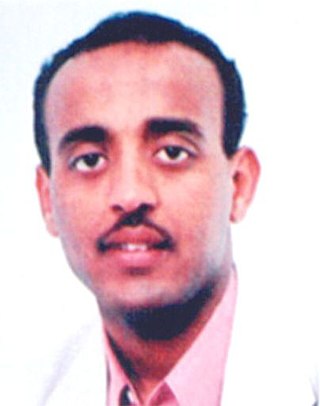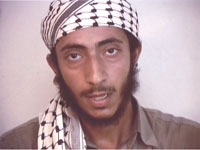Related Research Articles
The FBI Most Wanted Terrorists is a list created and first released on October 10, 2001, with the authority of United States President George W. Bush, following the September 11 attacks (9/11 incident). Initially, the list contained 22 of the top suspected terrorists chosen by the FBI, all of whom had earlier been indicted for acts of terrorism between 1985 and 1998. None of the 22 had been captured by US or other authorities by that date. Of the 22, only Osama Bin Laden was by then already listed on the FBI Ten Most Wanted Fugitives list.

Ramzi Mohammed Abdullah bin al-Shibh is a Yemeni citizen currently being held by the U.S. as an enemy combatant detainee at Guantanamo Bay in Cuba. He is accused of being a "key facilitator for the September 11 attacks" in 2001 in the United States.
Fawaz Yahya al-Rabeiee was an al-Qaeda terrorist, sentenced to death in 2004 by a Yemeni court for his part in the 2002 attack on the French tanker Limburg. Al-Rabeiee escaped custody in February 2006, with 22 other inmates, but was killed 1 October 2006 in San‘a’, along with another al-Qaeda suspect identified as Mohammed Daylami.

The FBI Seeking Terror Information list is the third major "wanted" list to have been created by the United States Department of Justice's Federal Bureau of Investigation to be used as a primary tool for publicly identifying and tracking down suspected terrorists operating against United States nationals at home and abroad. The first preceding list for this purpose was the FBI Ten Most Wanted Fugitives list. In 2001, after the September 11 attacks, that list was supplanted by the FBI Most Wanted Terrorists list, for the purpose of listing fugitives who are specifically wanted for acts of terrorism.

Muhammad Sa'id Ali Hasan al-Umda, also known as Gharib al-Taezi, was self-implicated on videotape as a possible terrorist in 2002, and was wanted by the United States Department of Justice's FBI, which was seeking information about his identity and whereabouts. He was once a bodyguard for Osama bin Laden and was a field commander for al-Qaeda in the Arabian Peninsula. In January 2002, he was discovered as one of five men who had been videotaped pledging martyrdom, and who were then consequently placed on the original version, upon inception, of the FBI's third major wanted list, which is now known as the FBI Seeking Information - War on Terrorism list. He was later removed by the FBI from the list after being detained by the Saudi government and then transferred to Yemen. He was convicted in 2005 of involvement in the 2002 attack on the MV Limburg oil tanker. In February 2006, he escaped from a Sana'a prison along with 22 other militants.
Alyan Muhammad Ali al-Wa'eli became wanted in 2002, by the United States Department of Justice's FBI, which was then seeking information about his identity and whereabouts. Ali al-Wa'eli was identified as a known associate of the Yemen cell leader, Fawaz Yahya al-Rabeei.
Omar Ahmad Omar al-Hubishi became wanted in 2002, by the United States Department of Justice's FBI, which was then seeking information about his identity and whereabouts. He was identified as a known associate of the Yemen cell leader, Fawaz Yahya al-Rabeei.
Bassam Abdullah bin Bushar al-Nahdi became wanted in 2002, by the United States Department of Justice's FBI, which was then seeking information about his identity and whereabouts. He was identified as a known associate of the Yemen cell leader, Fawaz Yahya al-Rabeei.
Ammar Abadah Nasser al-Wa'eli became wanted in 2002, by the United States Department of Justice's FBI, which was then seeking information about his identity and whereabouts. He was identified as a known associate of the Yemen cell leader, Fawaz Yahya al-Rabeei.
Mustafa Abdulkader Aabed al-Ansari was a Saudi national who organized and died in the 2004 Yanbu attack in Saudi Arabia. He was also the son-in-law of Yemeni al Qaeda operative Ahmad Mohammad Ali al-Hada. During the 1990s he fought in Afghanistan and Bosnia.
Samir Abduh Sa'id al-Maktawi became wanted in 2002, by the United States Department of Justice's FBI, which was then seeking information about his identity and whereabouts. He was identified as a known associate of the Yemen cell leader, Fawaz Yahya al-Rabeei.
Abdulrab Muhammad Muhammad Ali al-Sayfi, a Yemeni, became wanted in 2002, by the United States Department of Justice's FBI, which was then seeking information about his identity and whereabouts. He was identified as a known associate of the Yemen cell leader, Fawaz Yahya al-Rabeei.
Abu Nasr al-Tunisi, possibly a Tunisian, became wanted in 2002, by the United States Department of Justice's FBI, which was then seeking information about his identity and whereabouts. He was identified as a known associate of the Yemen cell leader, Fawaz Yahya al-Rabeei.
Abu Mu'az al-Jeddawi, a Saudi who reportedly lived in Yemen, is believed to have been rendered by the CIA to Jordan in early 2002. His real name is believed to be Ahmad Ibrahim Abu al-Hasana.
Issam Ahmad Dibwan al-Makhlafi, aka Akrama, became briefly wanted in 2002, by the United States Department of Justice's FBI, which was then seeking information about his identity and whereabouts. In early 2002, he had been named in a suspected Yemen plot, for which he became listed on the FBI's third major "wanted" list, now known as the FBI Seeking Information - War on Terrorism list. He was identified as a known associate of the Yemen cell leader, Fawaz Yahya al-Rabeei. But he was quickly discovered to already be in Yemen prison, and was promptly removed from the FBI "wanted" list. Very little else is known about him.
Ahmad al-Akhader Nasser Albidani became briefly wanted in 2002, by the United States Department of Justice's FBI, which was then seeking information about his identity and whereabouts. In early 2002, he had been named in a suspected Yemen plot, for which he became listed on the FBI's third major "wanted" list, now known as the FBI Seeking Information – War on Terrorism list. He was identified as a known associate of the Yemen cell leader, Fawaz Yahya al-Rabeei. But he was quickly discovered to already be in Yemen prison, and was promptly removed from the FBI "wanted" list. Very little else is known about him.
Bashir Ali Nasser al-Sharari became briefly wanted in 2002, by the United States Department of Justice's FBI, which was then seeking information about his identity and whereabouts. In early 2002, he had been named in a suspected Yemen plot, for which he became listed on the FBI's third major "wanted" list, now known as the FBI Seeking Information - War on Terrorism list. He was identified as a known associate of the Yemen cell leader, Fawaz Yahya al-Rabeei. But he was quickly discovered to already be in Yemen prison, and was promptly removed from the FBI "wanted" list. Very little else is known about him.
Abdulaziz Muhammad Saleh bin Otash, became briefly wanted in 2002, by the United States Department of Justice's FBI, which was then seeking information about his identity and whereabouts. In early 2002, he had been named in a suspected Yemen plot, for which he became listed on the FBI's third major "wanted" list, now known as the FBI Seeking Information – War on Terrorism list. He was identified as a known associate of the Yemen cell leader, Fawaz Yahya al-Rabeei. But he was quickly discovered to already be in Yemen prison, and was promptly removed from the FBI "wanted" list.
Shuhour Abdullah Mukbil al-Sabri became briefly wanted in 2002, by the United States Department of Justice's FBI, which was then seeking information about his identity and whereabouts. In early 2002, he had been named in a suspected Yemen plot, for which he became listed on the FBI's third major "wanted" list, now known as the FBI Seeking Information – War on Terrorism list. He was identified as a known associate of the Yemen cell leader, Fawaz Yahya al-Rabeei. But he was quickly discovered to already be in Yemen prison, and was promptly removed from the FBI "wanted" list. Very little else is known about him.
Abdullah Al-Rimi or Abdullah Ahmed Al-Remi,, has been described as an "important al-Qaeda recruiter", and became wanted in 2006 by the United States Department of Justice's FBI, "sought in connection with possible terrorist threats against the United States." He was one of 23 people who escaped from Yemen prison in San'a, including the Yemen cell leader, Fawaz Yahya al-Rabeei. Several weeks later he became listed on the FBI's third major "wanted" list, the FBI Seeking Information – War on Terrorism list. Very little else is known about him.
References
- ↑ "FBI - Seeking Information - 2-11-02". FBI. Archived from the original on 5 June 2002.
- ↑ "Most Wanted Terrorists". FBI. Retrieved 28 September 2016.
- ↑ "Seeking Information - Terrorism". FBI. Retrieved 28 September 2016.